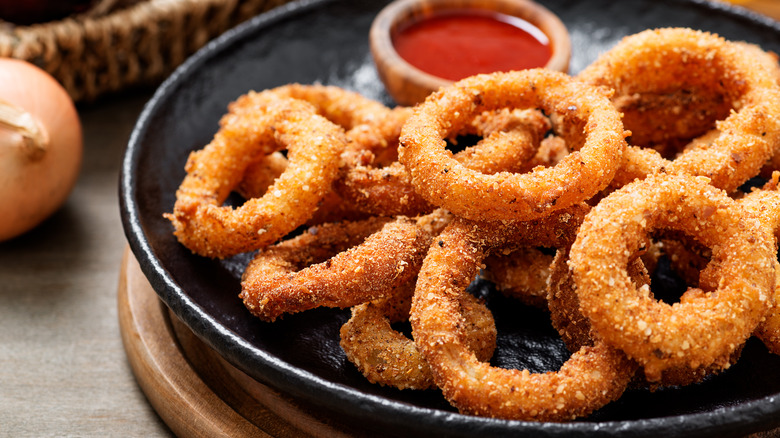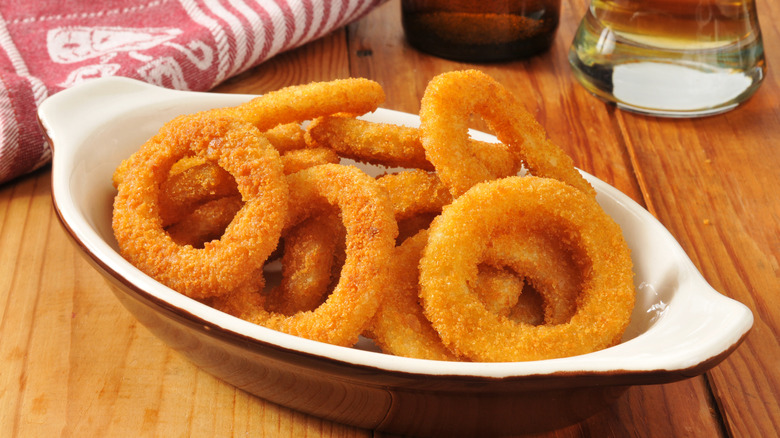Richard Blais' Game-Changing Tactics For The Crispiest Onion Rings
Onion rings: the perfect fusion between vegetables and deep-frying. Whether you're at the bar, ordering an appetizer, or just sitting at home, tearing into a few crispy, golden rings of fried onion always seems to hit the spot. Perhaps one of the best things about these addictively crunchy onion slices is that they sound incredibly easy to make — or at least on paper they do.
A good recipe for an onion ring includes only two major ingredients: the onion and the batter itself. All you have to effectively do is dunk the onion slices in the batter and toss them in the deep fryer until golden brown and then pat any excess oil off. What's so hard about that? If you're not being careful, there are a few mistakes you can very easily run into.
You may, for example, discover that your rings have absorbed an enormous amount of oil while frying, turning them into soggy, greasy clumps of par-cooked onion and oily batter. You could also find out that your batter may not stick and instead just slides off the onion in golden-brown chunks instead of adhering to the onion's surface. In either case, your onion rings are far from the crunchy and flavorful bar snack that you were imagining. Fortunately, chef Richard Blais has a very simple solution for ensuring that you get crispy onion rings all the time, and it involves something that's usually always paired up with a bowl of onion rings: beer.
Blais combines two methods of preparing onion rings
You've probably heard of beer-battered onion rings before, and Richard Blais' method does include the use of beer. But Blais' recipe isn't just standard for beer-battered onion rings; instead, it's a combination of two well-known methods of making onion rings in order to produce a light, crispy, yet firm batter for your rings.
Blais' recipe includes the usual list of ingredients one usually expects to find in a recipe for beer-battered onion rings, such as light ale or lager, baking soda, and flour. Where Blais deviates from the norm is that he also includes vodka in his recipe alongside the beer. Blais also "aerates" the batter in a siphon before dredging his onion rings in it. This aerating process is done by pouring the batter into a whipping siphon and filling it with a canister of pressurized nitrous oxide.
Once the vodka-beer batter is aerated, Blais dispenses the batter over the onion rings and then fries them in a saucepan filled with two inches of oil that have been heated to 350 degrees. Blais fries the rings for around three minutes per batch or until they have puffed up and are golden brown. The end result, then, is described as an onion ring that has a batter that is both flavorful and crisp without being too thick. But how exactly does the use of alcohol and aeration make for a better type of batter to begin?
The trick is getting air bubbles into the batter
Needless to say, Blais' method of making onion rings seems a little more involved than other onion ring recipes you're probably familiar with. Not only does he use a whipping siphon for his batter, but he also combines two types of alcohol. What exactly are the benefits?
The reason Blais combines beer and vodka is because of the properties of each drink. Beer not only adds air bubbles to the batter, but it also helps break down gluten that can build up in the batter, thus preventing the batter from becoming too thick and gluey. The vodka is added because it boils off faster than water, which keeps the batter from being runny or "wet" even when it's put in the fryer. The purpose of the whipping siphon, while optional, ensures that the batter has that light, "bubbly" texture to it by way of the nitrous oxide. The key factor in Blais' method is about getting your batter as light as possible, free from any heavy clumps of batter or being bogged down with excess moisture.
If you don't want to use alcohol in your recipe, another suggestion Blais' recipe includes is the use of club soda. This carbonated flavorless drink will add the bubbling effect that beer will have without introducing any alcohol to the end product. You can also add other types of alcohol if you wish, such as processco or sparkling wine, in place of beer and vodka.


